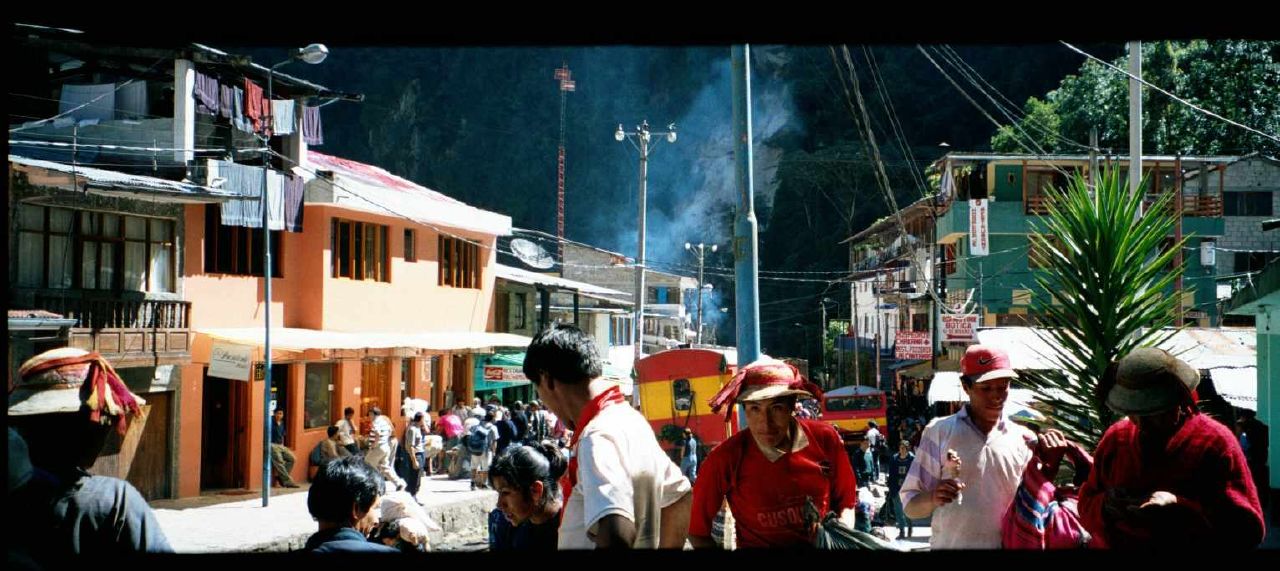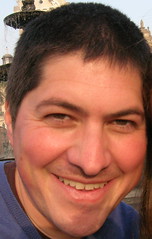6.30.2005
The Elvis of tango

Admirers of tango legend Carlos Gardel, assembling at his Buenos Aires tomb. Photo by Robert Wright.
Robert Wright, an American expatriate living in Buenos Aires, writes about the 70th anniversary of the death of Carlos Gardel, on June 23. He describes the man and his following:
"Before he died in a plane accident in Colombia 70 years ago today, Carlos Gardel brought tango to the world. A shining star in the 1920s & 30s, Gardel was a globetrotter, a ladies' man, a gambler, & a bon vivant... he knew how to live well so his inopportune death only served to fuel his legendary status.
There was a decent crowd throughout the day at Chacarita cemetery where he's buried. This is the only time his tomb is open to the public, & I couldn't pass that up. The guy in the photo was making sure that Gardel's statue always had a lit cigarette in his hand. How nice."

Statue of Carlos Gardel. Note the lit cigarette. Photo by Robert Wright.
Robert's blog, Line of Sight, is a treat. Besides his usual posts on life in Buenos Aires, it features some great and candid travel commentary from his recent trip to Morocco and Spain.
6.29.2005
Hey, it really works!
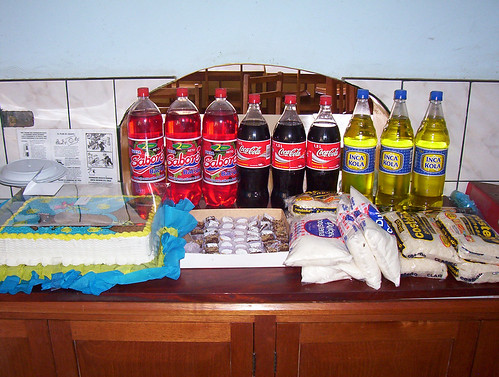
Care package, delivered safe and sound. Photo by Rebecca Verner.
A few weeks ago, I followed my own advice (see "One-click care packages") and used the Peruvian e-commerce site, Iquiero.com to have a care package delivered to the Zapallal children's refuge in Lima where my blogging friend Rebecca was volunteering. I ordered on a Sunday night and it arrived on a Tuesday, in time for Rebecca's tearful farewell.
So, it turns out that you can get quite a bit with $65, namely a Scooby-Doo cake that serves 20+, assorted pastries, nine bottles of pop and some assorted staples like rice and beans (to make a healthy meal when the kids come down from their sugar high). According to Rebecca, "The kids had to suffer through staring at that cake until well after dinner before they could have their faces plastered with multi coloured frosting!"
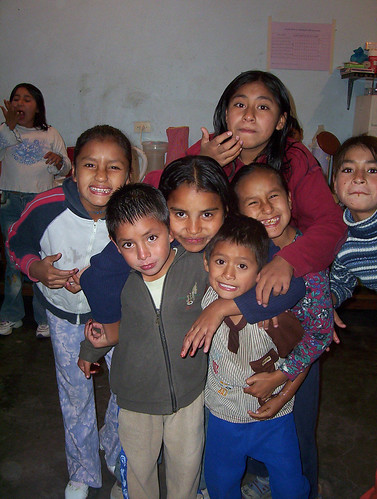
¡Azúcar! The kids of Zapallal, feeling the rush. Photo by Rebecca Verner.
Bien vestido
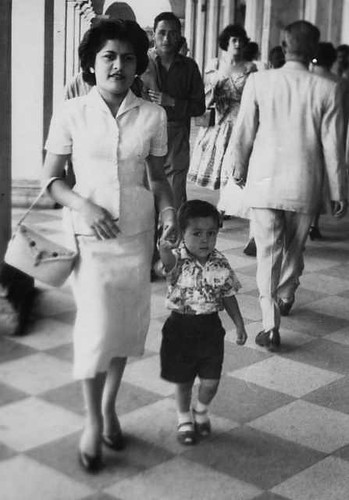
As long as we're rummaging through the family photo archives, here's my mother, Bertha Isabel Bernuy Carbajal, in 1955, walking through the arcade along Lima's Plaza de Armas, with my cousin Juan in tow.
Last week I stumbled onto a treasure trove of family photos from Lima in the 50s and 60s. Just like in the States, the men all wore suits and ties and the women wore dresses and heels -- even for informal family gatherings. Not only are those days long gone, but I doubt that they'll ever return.
6.28.2005
Abél Carbajal
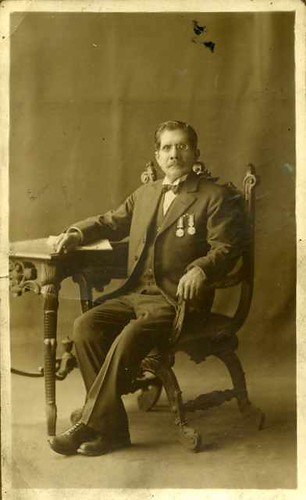
This is my great, great grandfather Abel Carbajal, who fought in what's known as the Great War of the Pacific. It was a conflict waged between Chile and Peru, over the guano trade. Bolivia was also somehow involved, because they lost their access to the sea as a result. Anyway, the story I've been told is that Abel was a prisoner of war and scheduled to be executed. (that part doesn't sound likely -- was it typical in that time to execute rank-and-file ordinary soldiers?) The day of or the day before he would've been shot, the war ended and he was ultimately freed. The metals on his chest are aparently from the war. The photo is from the early 1920s.
6.27.2005
Angélica Vivanco de Carbajal
6.13.2005
Cacique of the Nambikwara
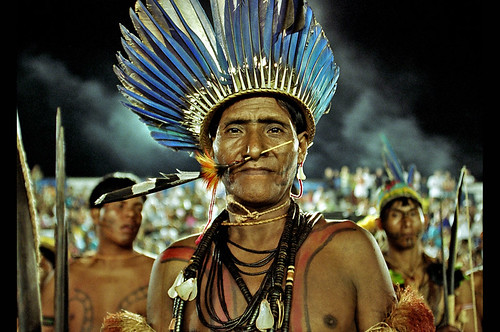
The leader of the Nambikwara, photographed at an indigenous people's meeting in Betioga, Brasil. Photo by Tatiana Cardeal.
" 'Cacique' means the Indian tribal chief. He is the leader of the 'People from the Ashes' and he emphasized it to me when I asked permission before taking his portrait.
They have a special ritual for this nose piercing. They do it to mark the puberty's masculine passageway, were the boy should show courage, firmness and spiritual power.
I looked to this photo more then a hundred times. First, i'm still asking why he was looking to me so deep. Second, i just can't believe that i did this one.
The Nambikwara live on the Mato Grosso State's west and Rondônia State from Brazil. Population about 998, in 1999."
The image and narrative above belongs to Tatiana Cardeal, from São Paulo, Brasil. Her images give flesh to people and tribal groups that are otherwise known to us via documentaries, statistics and stereotypes. And I'm the first to admit that I've generally lumped the tribes of the South American rainforest into an amorphous group and with little appreciation for the possibility that each group owns a history, a langauge and an understanding of life that is every bit as rich (even richer, according to many first-hand accounts) than our own.
I can't fathom what it means to be a person of the forest. Indeed, some of Tatiana's photos reinforce the fact that although we inhabit the same globe, we First-Worlders and the peoples of the rainforest are on different planets. But, occasionally, there's a glimpse of something familiar: a young child, distracted by curiosity, a musician lost in his composition, or silly girls mugging for the camera.
Deservingly, Tatiana has developed a huge following on her blog as well as her Flickr site. At both sites, she features her photographs along with haunting narratives.
Bustle
6.06.2005
Espiritu santo de Machu Picchu
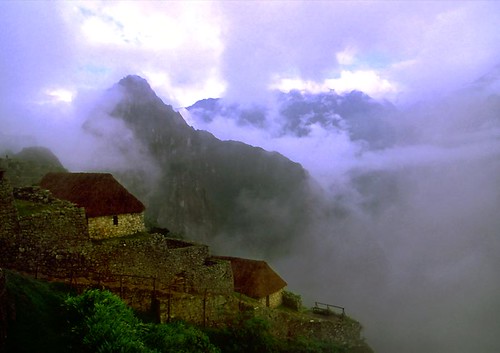
Fog at Machu Picchu. Photo by viiny.
Until now, I've deliberately resisted posting Machu Picchu photos. As with any breathtaking vista -- Yosemite, Grand Canyon, Pyramids at Giza -- a photo rarely does it justice. And neither do words. Of course, that never stops us from trying.
This photo, by one of my Flickr friends, Viiny, hints at the spiritual experience that many people have at the ruins. For some people, it's a new-agey thing. Like the Texans I once encountered at the top of Huayna Picchu, a nearby peak that overlooks the ruins. They were holding hands in a circle, their faces upward and eyes closed, singing "hello, hello, hellooo!" (Exactly like Moe, Larry and Curley did it in the opening credits of the Three Stooges). For others, including me, it's a quiet, but profound sense of awe and awareness of the souls who once inhabited this strange landscape. The power of the place comes not so much from what it means to me, but what it must've meant to them.
Several years ago, I hiked the Inca Trail with my brother in law Brian (another story, which I'll let him tell someday). Our last night on the trail before reaching the ruins, we camped a mile or so outside the ruins. Next morning, we woke before dawn and made our way to the Intipunku (Sun Gate), a ruin overlooking the entirety of Machu Picchu, to watch sunrise over the ruins. As luck would have it, we saw nothing but fog where the ruins should be. Aside from seeing what I took to be an omen -- an irridescent hummingbird buzzing a couple feet away from me -- I was dissapointed.
Then something appeared to move within the fog itself. We watched as, in the space of no more than two minutes, the fog pulled in from the edges and condensed into a single cloud, which then quickly rose skyward, revealing the pristine ruins beneath it. It was as if they knew we were coming and had gift wrapped the ruins for us to open with our eyes.
6.04.2005
The real thing

Coca leaves for sale in Potosí, Bolivia. Photo by teamtrev.
Have you ever tried coca? Numerous acquaintances of mine are familiar with the powdered form (not me --- I guess the 80s passed me by). I've only chewed the leaves and drunk the tea.
Coca is a sacred part of Andean culture. Since ancient times, spiritual healers have cast coca leaves onto the ground and read the future in them, much as a psychic would purport to read a crystal ball.
Before the Spanish, only Inca nobility were permitted to chew the leaf. Now, even the poorest of souls chew it, if only because it takes the edge off hunger and boosts one's ability to toil at high altitudes.
Coca leaves are not particularly intoxicating. Considering that it would take bushels of the leaves (rendered down with gallons of toxic chemicals) to create the smallest amount of cocaine, you can imagine how the leaves themselves must not be terribly potent. It's safe to say that the effect of coca in leaf form is just a foreshadowing of the power of the drug. The leaves aren't particularly yummy, either. They're mild and have a slight aftertaste of novacaine.
Coca tea, on the other hand, is quite nice. The flavor is mild and herbaceous, akin to a weak green tea. I've drunk gallons of the stuff, sometimes for pleasure, but mostly in a desperate effort to fight off the headache and nausea that comes with "soroche", or altitude sickness. Coca tea is widely available in supermarkets in Perú and Bolivia.
I know that back in the day, cocaine was overtly advertised as one of the active ingredients in Coca-Cola. You'd think the coca would've been long eradicated.* But I was surprised to read the other day that coca is still an ingredient. But don't worry. It's been "decocainized" for your protection.
*Spike is the herbide used by the DEA in Peru (and other Andean countries?) to eradicate coca crops in the mid-t0-late 90s.
One-click care packages
Thanks to everyone who expressed interest in a crazy idea from an earlier post, in which I described an online service, based in Lima, that I used for sending flowers and cakes to my abuelita. This same service also delivers baskets of basic food items -- noodles, rice, beans, milk, flour, sugar, etc.
So why can't we use this same service to fill the pantry of a needy family in Lima? We can. And that's what we're gonna do.
Rebecca, a blogging friend, responded by identifying two worthy recipients. One of the places is a children's refuge, where she currently volunteers.
So, if you've got a soft spot for children and can spare between $17 and $52, please read on! We'll show you what you can order, who you can send it to and how to make your purchase on Iquiero.com.
Step 1: Choose a recipient
Here are two worthy institutions that my friend Rebecca has been working with:
Las Laderas community kitchen
At Las Laderas, parents (mostly moms) have banded together to be able to feed and educate their kids more effectively.
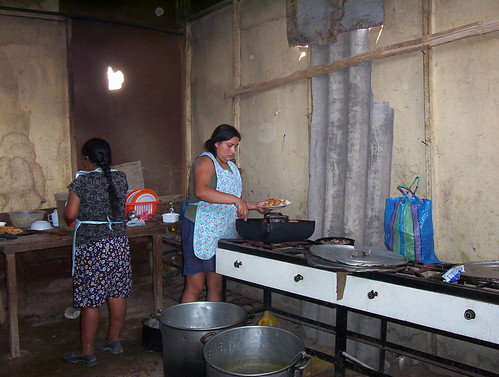
Above, some moms prepare food in the community kitchen. Note the basic equipment and utensils, which are sometimes stolen.
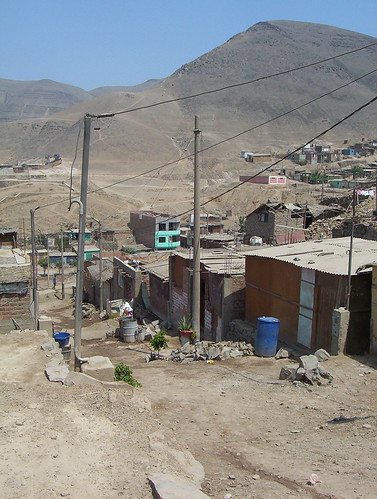
The neighborhood outside does have electricity, but lacks most other basic services.
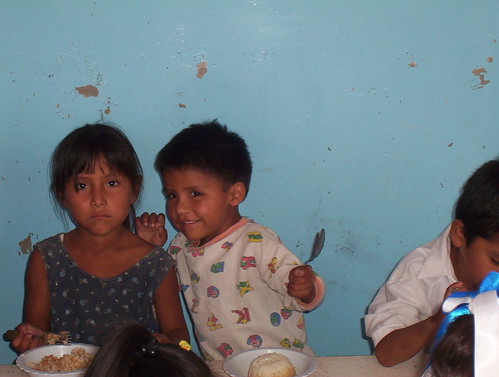
But kids are kids the world over. Here are some of the beautiful children who eat at the Las Laderas kitchen.
Address: (these instructions show how to format this address when you order online)
show how to format this address when you order online)
Rosa Romero Sancho
Mz. E Lote 19
Las Lederas de Chillon
Puente Piedras, Lima 22
Perú
Local phone #: 551 0015
Zapallal children's refuge
The refuge is officially sponsored by Project Peru, a bonafide charity in England.

The kids at Zapallal get three squares a day, thanks to the donations of people from around the world.

They also get to spend time doing kid stuff -- putting on plays, learning crafts, jumping on trampolines, riding bikes, etc. -- all activities that poor kids in Perú rarely get to participate in.
Address: (these instructions show how to format this address when you order online)
show how to format this address when you order online)
Lucinda Taboada Peña De Odar
Proyecto Peru
Mz. P2 Lt4 Calle Santa Patricia
El Dorado - Zapallal
Puente Piedra, Lima 22
Perú
Local phone #: 550 2209
Step 2: Choose a care package
Iquiero offers different sized "baskets" (do they include an actual basket? I'm not sure.) that include differing quantities of kitchen essentials. Logically, the bigger baskets include more stuff and a greater variety of stuff. Just click on any of the items below. You'll be taken to the appropriate product page on Iquiero.com. If you know Spanish, it'll be easy to check out and pay for your gift. Otherwise, you can download these printable, step-by-step instructions .
.
Grocery "Baskets" (see below for different sizes)

The Complete Basket
This is the whopper and includes just about every comestible you can think of, from flour to beans to ketchup. Check out my earlier posting for a complete list. Cost: $52
The Premium Basket
Most of the same stuff as in the Complete Basket, but in smaller quantities. Cost: $40.10
The Pantry Basket
Fewer items, slightly smaller quantites. Still enough to make some great nutritious meaals. Cost: $35.60
The Economy Basket
A great choice if you're feeling a little tight on funds! Cost: $25.20
Combination Packages (see below for different sizes)

Large combination package
Includes even more noodles, rice, evaporated milk and sugar. Cost: $17
Medium combination package
Includes noodles, rice, evaporated milk and sugar. Cost: $14
Small combination package
Includes noodles, rice & evaporated milk. Cost: $13
So why can't we use this same service to fill the pantry of a needy family in Lima? We can. And that's what we're gonna do.
Rebecca, a blogging friend, responded by identifying two worthy recipients. One of the places is a children's refuge, where she currently volunteers.
So, if you've got a soft spot for children and can spare between $17 and $52, please read on! We'll show you what you can order, who you can send it to and how to make your purchase on Iquiero.com.
Step 1: Choose a recipient
Here are two worthy institutions that my friend Rebecca has been working with:
Las Laderas community kitchen
At Las Laderas, parents (mostly moms) have banded together to be able to feed and educate their kids more effectively.

Above, some moms prepare food in the community kitchen. Note the basic equipment and utensils, which are sometimes stolen.

The neighborhood outside does have electricity, but lacks most other basic services.

But kids are kids the world over. Here are some of the beautiful children who eat at the Las Laderas kitchen.
Address: (these instructions
 show how to format this address when you order online)
show how to format this address when you order online)Rosa Romero Sancho
Mz. E Lote 19
Las Lederas de Chillon
Puente Piedras, Lima 22
Perú
Local phone #: 551 0015
Zapallal children's refuge
The refuge is officially sponsored by Project Peru, a bonafide charity in England.

The kids at Zapallal get three squares a day, thanks to the donations of people from around the world.

They also get to spend time doing kid stuff -- putting on plays, learning crafts, jumping on trampolines, riding bikes, etc. -- all activities that poor kids in Perú rarely get to participate in.
Address: (these instructions
 show how to format this address when you order online)
show how to format this address when you order online)Lucinda Taboada Peña De Odar
Proyecto Peru
Mz. P2 Lt4 Calle Santa Patricia
El Dorado - Zapallal
Puente Piedra, Lima 22
Perú
Local phone #: 550 2209
Step 2: Choose a care package
Iquiero offers different sized "baskets" (do they include an actual basket? I'm not sure.) that include differing quantities of kitchen essentials. Logically, the bigger baskets include more stuff and a greater variety of stuff. Just click on any of the items below. You'll be taken to the appropriate product page on Iquiero.com. If you know Spanish, it'll be easy to check out and pay for your gift. Otherwise, you can download these printable, step-by-step instructions
 .
.Grocery "Baskets" (see below for different sizes)

The Complete Basket
This is the whopper and includes just about every comestible you can think of, from flour to beans to ketchup. Check out my earlier posting for a complete list. Cost: $52
The Premium Basket
Most of the same stuff as in the Complete Basket, but in smaller quantities. Cost: $40.10
The Pantry Basket
Fewer items, slightly smaller quantites. Still enough to make some great nutritious meaals. Cost: $35.60
The Economy Basket
A great choice if you're feeling a little tight on funds! Cost: $25.20
Combination Packages (see below for different sizes)

Large combination package
Includes even more noodles, rice, evaporated milk and sugar. Cost: $17
Medium combination package
Includes noodles, rice, evaporated milk and sugar. Cost: $14
Small combination package
Includes noodles, rice & evaporated milk. Cost: $13
6.03.2005
Buddy, can you spare a clip?
A few of you already know that this blog is an attempt by me to seek notoriety and riches. And we're making progress. My Google ad revenue is already pushing $3.
But let's say, for the sake of argument, that the riches thing falls through. I still hope this blog will help me snag a few newspaper and magazine writing assignments and justify a trip to South America later this year or early next year.
There's just this little matter of "clips." Editors typically demand to see clips -- examples of recent articles you've written -- so they know you can write something they'd actually want to publish. And I don't imagine a brochure on mutual fund investing (typical of what I've been writing the past 15 years) doing much to quicken the pulse of a jaded newspaper editor.
That's where the blog comes in. It's my shortcut for getting past this clip dilemma. I'm hoping this blog will (1) convince prospective editors that I can indeed write and (2) that I have a peso of familiarity with the subject.
A third purpose for the blog just struck me today: that I can solicit story ideas from you, my dear readers, and also try out some ideas on y'all before crafting my pitch letters to the media elite.
So are you game for some open-source journalism? I should be ready to post a slew of story ideas over the next couple weeks. Meanwhile, I'd like to ask you:
But let's say, for the sake of argument, that the riches thing falls through. I still hope this blog will help me snag a few newspaper and magazine writing assignments and justify a trip to South America later this year or early next year.
There's just this little matter of "clips." Editors typically demand to see clips -- examples of recent articles you've written -- so they know you can write something they'd actually want to publish. And I don't imagine a brochure on mutual fund investing (typical of what I've been writing the past 15 years) doing much to quicken the pulse of a jaded newspaper editor.
That's where the blog comes in. It's my shortcut for getting past this clip dilemma. I'm hoping this blog will (1) convince prospective editors that I can indeed write and (2) that I have a peso of familiarity with the subject.
A third purpose for the blog just struck me today: that I can solicit story ideas from you, my dear readers, and also try out some ideas on y'all before crafting my pitch letters to the media elite.
So are you game for some open-source journalism? I should be ready to post a slew of story ideas over the next couple weeks. Meanwhile, I'd like to ask you:
- Of all the items you've seen on this blog, which postings seem to have the greatest article potential?
- What South American tidbits have you run across elsewhere that might make good feature or travel-article fodder?
- If you answered either of the above...in what kinds of publications might you expect to see such an article? Go ahead and name specific publications.
6.02.2005
From horror to hope

Untitled, by Felícitas Flores Laura, a resident of Paccha, Perú
I recently discovered a Web site that depicts the horrors of Perú's 20-year civil war (1980-2000). Called Yuyarisun, the site is an archive of testimonies, drawings, poetry and comics created by peasants of the neighboring departments of Ayacucho and Huancavelica, the epicenter of the conflict.
The images on this site convey how completely the relatively peaceful lives of Andean peasants were shattered by the violence of raiding guerrillas and soldiers. Goya himself coudn't have done it better.
The picture above is particularly touching for me because it comes from Paccha, a village outside of Ayacucho that was visited one fateful night by Sendero Luminoso, or, the Shining Path. I've had the privilege of meeting one of the survivors of Paccha, a talented but ever-so-humble weaver named Wilbur Quispe.
Wilbur sells his artwork through ArtAndes in Minneapolis, which is run by Melanie Ebertz. Melanie has used proceeds from ArtAndes to launch a Comunidad a teeny non-profit foundation that has adopted Paccha. Among its good deeds, Comunidad has purchased a diesel-powered flour mill for the village (saves time, creates revenue!), currently pays the salaries of five teachers and is funding the planning and eventual construction of a school where Wilbur will teach homeless kids to become weavers, like someone once taught him.
I've heard lots of bits and pieces about Wilbur's story and the story of Paccha, but nobody has captured it better than Melanie's sister Jessica, who describes her visit to Paccha in A Durable Weave (PDF | 4 pages | 204KB). I highly recommend it -- it's an uplifting read!
Bonus extra: I just found out that Wilbur is in town, demonstrating his weaving on Tuesday and Thursday nights at the ArtAndes gallery. He'll also be meeting people at the ArtAndes booth at the Minneapolis Farmers' Market on Saturdays and Sundays.
6.01.2005
Snap music inspection
It seems I've caught a music meme, which calls on me to describe my musical state of affairs.
1) Who passed it to me:
Eduardo at Barrio Flores
1) Who passed it to me:
Eduardo at Barrio Flores
2) Total volume of music files in my PC:
49 GB
3) Last CD I bought:
Spymob - Sitting Around Keeping Score
4) Which song I'm currently listening :
"Lazy Lover" by Brazilian Girls
5) Five songs I've been listening to frequently:
- Fire Coming Out of a Monkey's Head, by Gorillaz, on Demon Days
- Hell Yes, by Beck, on Guero
- Strawberry Fields Forever, by Los Fabulosos Cadillacs, on Rey Azúcar (a killer Ska cover!)
- Worlds, by Jurassic 5, on Jurassick! (Freestyles and Rareties)
- Everything is Everything, by Phoenix, on Alphabetical
- Nanny Nanny Boo Boo, by Le Tigre, on ?? (It's not on the their most recent CD, anyway)
- Round About Midnight (Thelonious Monk), by Gotan Project, on Inspiración-Espiración Remix
- The Heart's A Lonely Hunter, by Theivery Corporation (feat. David Byrne), on The Cosmic Game
Geez, is this a schizophrenic list or what? And yes, I know that's more than five! Never could follow directions, anyway.
- Patrick @ Barrybar's Photos
- Rebecca @ Rebel's Peruvian Adventure
- Mark @ Dishwasher Safe
- Michael @ An American's View of France
- Eric @ Paris, one photo a day
- Kyle @ the Experience Journal
Bajo Cerro
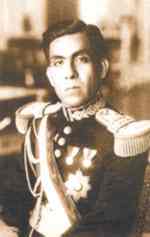
Well, he doesn't look like the nicest guy, but I know of at least one person who shed a tear for him when he died.
Above is a picture of Peruvian president Luis Miguel Sánchez Cerro, who was assassinated in the presidential palace during the military coup of 1933. At the time, my great grandfather Otoniel served as an officer in the presidential guard. The story goes that Abuelito returned home that day in tears, having witnessed the assassination. I don't know how it all took place. For instance, did any of the guards try to shield the president, Secret-Service style, or did they simply step aside (likely, given that they were under the command of the military)?


